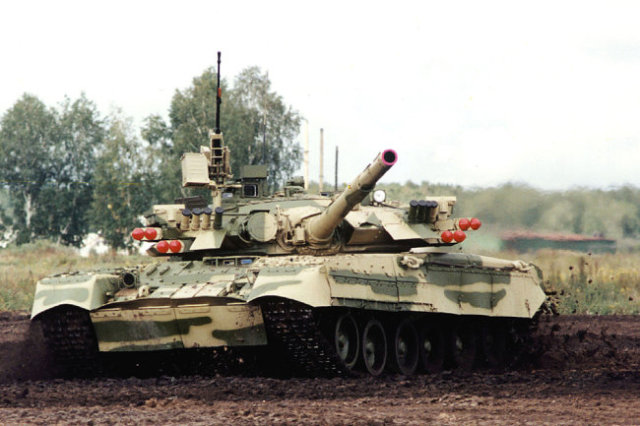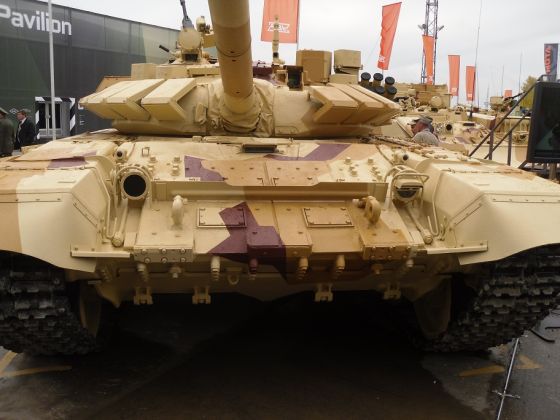In early April, the Rostec State Corporation's High-Precision Complexes holding reported on successful tests of the Arena-M active protection complex installed on the T-72 tank. The defensive system repelled the attack using not only Russian anti-tank missile systems (ATGMs), but also foreign ammunition. About how domestic protective complexes for armored vehicles were created and what is the uniqueness of "Arena-M" — in the material of TASSThe Javelin Killer
According to the Rostec Telegram channel, the main purpose of the tests was to check KAZ "Arena-M" (upgraded) for protection against hits of anti-tank grenades and anti-tank guided missiles (ATGM). The T-72 tank acted as the carrier of the complex. According to military expert Vasily Dandykin, today it is the main Russian combat vehicle participating in a special military operation.
"An upgraded tank with a thermal imager and dynamic protection (containers made of steel plates with explosives located on the armor and reducing the penetration capacity of a cumulative projectile — approx. TASS) received another very important element — active protection, which does not allow an enemy projectile to approach the tank. The Arena-M complex is capable of repelling attacks not only by Javelin and Spike-type ATGMs, but also, importantly, depleted uranium ammunition, which, judging by the latest data, the West is going to supply to the APU. In addition, the upgraded Arena will increase the level of protection of our T-72s in possible tank duels with Abrams and Leopard arriving in Ukraine," the expert said in an interview with TASS.
As previously reported by TASS with reference to sources in the High-Precision Technologies holding, during the tests, Arena-M confirmed its effectiveness.
In the foreign press, the new Russian active protection complex has already been dubbed the Javelin killer, and the American online publication Popular Mechanics called the "Arena" relieving tankers of one of the main "headaches" - cumulative projectiles.
"Porcupine", "Fan" and "Thrush"
Weapons that could hit armored vehicles with cumulative projectiles appeared in the arsenal of world military powers during the Great Patriotic War. The principle of operation of these ammunition was based on the formation after the explosion of a thin, narrowly directed cumulative jet, having a speed of several kilometers per second and being under a gigantic pressure of hundreds of thousands of atmospheres, capable of burning through even the thickest tank armor.
In order to protect combat vehicles from a new threat, military equipment designers have begun work on creating protective complexes that could be installed on armor and eliminate the danger even on approach.
In the USSR, work on the creation of the first complex of protection against anti-tank shells began in the mid-1960s. The project of a system capable of detecting ammunition, determining the parameters of its movement, and then destroying it was called "Porcupine". The protective kit, consisting of a locator and launchers, made it possible to shoot at approaching projectiles, but the accuracy left much to be desired.
Design research continued, and soon a "Fan" appeared — a tank protection complex with optical detection sensors. According to the engineers' idea, it was supposed to identify the impending threat faster and more accurately, but due to the sensitivity of the sensors to contamination, the "Fan" had to be abandoned.
Next, in the 1970s, Azot appeared with a two-stage radar resistant to interference, which significantly reduced the number of false positives — a problem of almost all early domestic KAZ.
According to experts, all these developments can be called short-range complexes that began to work when the projectile was already approaching a critically close distance of several meters. Meanwhile, the ideal that the designers aspired to was a long-range KAZ capable of detecting a threat to the tank and its crew at a distance of 20 to 500 m, choosing the optimal counter-munition for its destruction and doing all the work in a matter of seconds.
 |
| The T-80 U tank with the Drozd active protection complex. |
| Source: Tatiana Kavtsevich / TASS |
As a result, in 1978, the Drozd was developed, which can be called the first full-fledged complex of active long-range protection. Initially, the defense system was installed on the T-55 AD tank and consisted of eight guides with anti-missiles and a 24.5 GHz radar that could see projectiles threatening the tank at a distance of up to 330 m. Then the radar switched to target tracking mode, and the electronic computer calculated the speed, angle of approach and the meeting point of the ammunition and the protective charge. Based on the information received, the electronics gave the command to fire, after which the "Thrush" switched back to detection mode.
On September 12, 1983 KAZ "Drozd" was adopted by the Soviet Army.
"Arena"
The predecessor of the modern Arena-M KAZ Arena was developed in the early 1980s at the Kolomna Engineering Design Bureau (KBM). The main difference of the complex from all the previous ones was the defeat system. The Arena counter-munition was fired not towards the anti-tank projectile, but upwards and attacked the target from a height.
Despite the high characteristics of the first "Arena" — first of all, the all-course protection of not only heavy armored vehicles, but also light infantry fighting vehicles such as BMP-2 and BMP—3 - it was not adopted. Nevertheless, a reserve was created that allowed the designers to create the most spectacular complex, not inferior to modern world analogues.
In January 2017, TASS published an interview with the general designer of KBM Valery Kashin, who spoke about the beginning of preliminary tests of the new Arena-M on the T-72 tank.
"The conflicts in the Middle East have shown that, firstly, there is nowhere without tanks, and secondly, it is no longer possible to provide them with full-fledged protection by traditional means, including dynamic protection — tanks are beaten and they burn," said the general designer of the KBM.
The current April tests have shown that the Arena-M copes with its tasks, actually carrying out a circular defense of the tank. This was told on the air of the Zvezda TV channel by the head of the department of development and advanced design of the KBM, Vladimir Kharkov. According to him, Arena-M "protects the tank, including in the upper sphere, from almost the entire range of ammunition."
According to the expert, the first attacking projectile is met by a multifunctional radar station with high noise immunity. To destroy the target, high-speed ammunition is used, which explode and hit with a directed stream of heavy fragments at ranges from 20 to 50 m. In addition, the Arena-M counter-munition can adjust its own course due to impulse engines in flight, turning towards the threat.
For reliability, Arena-M releases two protective explosive ammunition for the destruction of each attacker.
The closest foreign analogue of the Russian KAZ is the Israeli Trophy—HV from the state military concern Rafael Advanced Defense Systems Ltd. This is the most common complex in the West, which is now installed on the latest American M1A2C Abrams. According to open sources, Trophy-HV allows you to intercept only subsonic ammunition, while Arena-M is capable of destroying all types of ATGM, including supersonic. The speed of its counter-munition reaches 1200 m/ s, which exceeds the speed of sound at the ground.
In the future, as reported by TASS in the High-Precision Technologies holding, the Arena-M can be installed on T-90 and T-80 tanks.
Prepared by Vasily Kuchushev



